| Date | Text | |
|---|---|---|
30 Nov 1905
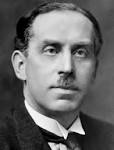
Charles Barkla |
Charles Barkla (chemistry) Charles Barkla discovers that each element has a characteristic X-ray and that the degree of penetration of these X-rays is related to the atomic weight of the element. |
|
30 Nov 1905
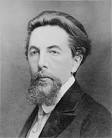
Mikhail Tsvet |
Mikhail Tsvet (chemistry) Mikhail Tsvet first names the chromatography technique for organic compound separation, in the course of demonstrating that chlorophyll is not a single chemical compound. |
|
30 Nov 1905

Richard Oldham |
Richard Oldham (geology) Richard Oldham argues that the Earth has a molten interior. |
|
30 Nov 1905

Andrey Markov |
Andrey Markov (mathematics) Andrey Markov produces his first theories on Markov chain processes. |
|
30 Nov 1905
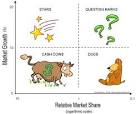
BCG |
BCG (medicine) BCG (Bacilli-Calmette-Guerin) immunization for Tuberculosis first developed. |
|
30 Nov 1905

dengue fever |
dengue fever (medicine) Transmission of dengue fever by the Aedes mosquito is confirmed. |
|
30 Nov 1905

Frederick Hopkins |
Frederick Hopkins (medicine) Frederick Hopkins suggests the existence of vitamins and suggests that a lack of them causes scurvy and rickets. |
|
30 Nov 1905

Clemens Peter von Pirquet |
Clemens Peter von Pirquet (medicine) Clemens Peter von Pirquet, with Béla Schick, coins the term "allergy" to describe hypersensitive reactions. |
|
30 Nov 1905

Royal Victoria Hospital, Belfast |
Royal Victoria Hospital, Belfast (medicine) Royal Victoria Hospital, Belfast, is completed, the first such air conditioned building in the world. |
|
30 Nov 1905

George Newman |
George Newman (medicine) George Newman publishes Infant Mortality: a Social Problem in England. |
|
30 Nov 1905
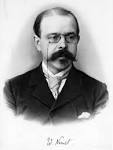
Walther Nernst |
Walther Nernst (physics) Walther Nernst presents a formulation of the third law of thermodynamics. |
|
30 Nov 1905
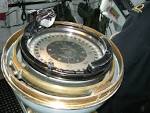
gyrocompass |
gyrocompass (technology) The first practicable gyrocompass is invented by Hermann Anschütz-Kaempfe in Germany. |
|
30 Nov 1905
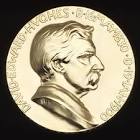
Hughes Medal |
Hughes Medal (awards) Hughes Medal – Hertha Ayrton |
|
30 Nov 1905

Old Style |
death Old Style January 13 (Old Style December 31, 1905) – Alexander Stepanovich Popov (born 1859), Russian physicist. |
|
01 Jan 1906

Lee De Forest |
Lee De Forest (technology) Lee De Forest files a patent for the Audion vacuum tube, which helps usher in the age of electronics. |
|
06 Jan 1906
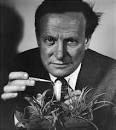
G. Ledyard Stebbins |
birth G. Ledyard Stebbins G. Ledyard Stebbins (died 2000), American botanist and geneticist. |
|
10 Jan 1906
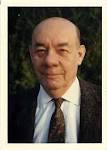
Grigore Moisil |
birth Grigore Moisil Grigore Moisil (died 1973), mathematician. |
|
11 Jan 1906

Albert Hofmann |
birth Albert Hofmann Albert Hofmann, (died 2008) chemist. |
|
02 Feb 1906

Samuel Cunliffe Lister |
death Samuel Cunliffe Lister Died 2 Feb 1906 at age 91 (born 1 Jan 1815). Samuel Cunliffe Lister, 1st Baron Masham of Swinton was an English industrialist and inventor of successful wool-combing and waste-silk spinning machines. The demand for wool that resulted from less expensive products stimulated the Australian wool trade. By 1856, he had several mills in Yorkshire, and abroad. He also created machines to use “chassum,” comprising damaged cocoons, remnants or fibres previously rejected as waste in silk-spinning. By 1867, after ten years in development, eventually those machines made him a further fortune. In 1867, he introduced velvet power looms for making piled fabrics. His inventiveness included a 1848 patent for automatic compressed air brakes for railways. The textile manufacturing company he established in 1838 exists today. |
|
03 Feb 1906

George Adamson |
birth George Adamson George Adamson (died 1989), wildlife conservationist. |
|
04 Feb 1906

Clyde Tombaugh |
birth Clyde Tombaugh Clyde Tombaugh (died 1997), astronomer. |
|
10 Feb 1906
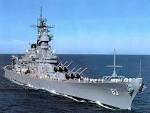
battleship |
battleship (technology) Launch of battleship HMS Dreadnought. |
|
18 Feb 1906

Hans Asperger |
birth Hans Asperger Hans Asperger (died 1980), pediatrician. |
|
27 Feb 1906
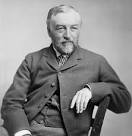
Samuel Pierpont Langley |
death Samuel Pierpont Langley Died 27 Feb 1906 at age 71 (born 22 Aug 1834). American astronomer, physicist and aeronaut who built the first heavier-than-air flying machine to achieve sustained flight. He launched his Aerodrome No.5 on 6 May 1896 using a spring-actuated catapult mounted on top of a houseboat on the Potomac River, near Quantico, Virginia. He also researched the relationship of solar phenomena to meteorology. |
|
08 Mar 1906

Henry Baker Tristram |
death Henry Baker Tristram Henry Baker Tristram (born 1822), English ornithologist. |
|
18 Mar 1906

Romanian |
Romanian (technology) Romanian inventor Traian Vuia becomes the first person to fly a heavier-than-air monoplane with unassisted takeoff, at Montesson in France. |
|
31 Mar 1906

Shin-ichiro Tomonaga |
birth Shin-ichiro Tomonaga Born 31 Mar 1906; died 8 Jul 1979 at age 73. Japanese physicist who shared the Nobel Prize for Physics in 1965 (with Richard P. Feynman and Julian S. Schwinger of the U.S.) for independently developing basic principles of quantum electrodynamics. He was one of the first to apply quantum theory to subatomic particles with very high energies. Tomonaga began with an analysis of intermediate coupling - the idea that interactions between two particles take place through the exchange of a third (virtual particle), like one ship affecting another by firing a cannonball. He used this concept to develop a quantum field theory (1941-43) that was consistent with the theory of special relativity. WW II delayed news of his work. Meanwhile, Feynman and Schwinger published their own independent solutions. |
|
18 Apr 1906
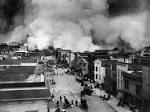
San Francisco earthquake |
San Francisco earthquake (geology) The San Francisco earthquake, an estimated 7.9 on the Richter scale and centered on the San Andreas fault, strikes near San Francisco, California. The earthquake and fire destroy over 80% of the buildings in the city, and kill as many as 6,000 people. Harry Fielding Reid devizes the elastic-rebound theory to account for earthquake mechanism. |
|
19 Apr 1906

Pierre Curie |
death Pierre Curie Pierre Curie (born 1859), French winner of the Nobel Prize in Physics. |
|
25 Apr 1906
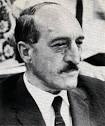
Meyer Fortes |
birth Meyer Fortes Born 25 Apr 1906; died 27 Jan 1983 at age 76. English social anthropologist who is known for his investigations of West African societies. He originally training in psychology, but in 1932 turned to anthropology—which is reflected in his later works on ancestor worship. He was primarily interested in family and kinship, and made field studies (1934–37) with the Tallensi and Ashanti in Ghana. His monographs on these studies laid the foundations for the theory of descent, a cornerstone of the “structural-functionalism” dominating the social anthropology of the 1950s and 60s. His major contributions in lineage theory, studies of religion and ancestor worship set the standard for all subsequent studies of African social organization. He was professor of social anthropology at Cambridge University (1950-73). |
|
28 Apr 1906

Kurt Gödel |
birth Kurt Gödel Kurt Gödel (died 1978), mathematician. |
|
15 May 1906

James Blyth |
death James Blyth James Blyth (born 1839), Scottish electrical engineer. |
|
19 May 1906
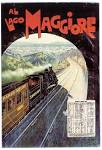
Simplon Tunnel opened |
Simplon Tunnel opened In 1906, the Simplon Tunnel was officially opened as the world's longest railroad tunnel. Cutting through the Alps between Italy and Switzerland, it was officially opened by the King of Italy and the president of the Swiss Republic. The construction of the 12-mile Simplon Tunnel, one of the world's longest rail tunnels was undertaken in the 1890s by Alfred Brandt, head of a German engineering firm, and inventor of an efficient rock drill. The total length of the tunnel is 64,972 feet cut through the solid rock of the Simplon Mountain between the Rhone and the Diveria valley. As a direct route under the mountain, it considerably shortened the surface distance for an important European trade route between Brig, Switzerland and Iselle, Italy. |
|
29 May 1906
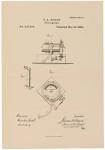
Edison patents |
Edison patents In 1906, Thomas A. Edison was issued a series of U.S. patents, (Nos 821,622 - 821,627), respectively for a "Process of Cleaning Metallic Surfaces" in the form of long continuous strips to prepare for coating (ex. by electroplating); as for a "Storage-Battery-Filling Apparatus," which provided a means to indicate when the proper filling level of solution has been reached; a "Gas-Separator for Storage Batteries"; a "Process of Treating Alkaline Storage Batterie"; a "Process of Making Metallic Films or Flakes"; and a "Process of Making Metallic Flakes or Scales." |
|
10 Jun 1906

Mary Putnam Jacobi |
death Mary Putnam Jacobi Died 10 Jun 1906 at age 63 (born 31 Aug 1842). (née Mary Corinna Putnam) American physician, well-respected for her medical abilities, who advocated social reform to expand educational opportunities for women by providing the same training and clinical practice as men. She was awarded Harvard University's Boylston Prize for her 1876 essay, The Question of Rest for Women during Menstruation. In this work, she refuted allegations of the physical limitations of women, such as published by Dr. Edward H. Clarke's in Sex in Education (1873). She supported her position with scientific data including sphygmographic tracings of pulse rate, force, and variations to confirm that a woman maintained vigorous health throughout her monthly cycle. Jacobi became the first female member of the Academy of Medicine. |
|
13 Jun 1906

Bruno de Finetti |
birth Bruno de Finetti Bruno de Finetti (died 1985), statistician. |
|
18 Jun 1906

Orvan Hess |
birth Orvan Hess Orvan Hess (died 2002), obstetrician. |
|
22 Jun 1906

Fritz Schaudinn |
death Fritz Schaudinn Died 22 Jun 1906 at age 34 (born 19 Sep 1871). Fritz Richard Schaudinn was a German zoologist and microbiologist who, with dermatologist Erich Hoffmann, discovered (1905) the spirochaete which causes syphilis, Spirochaeta pallida, now known as Treponema pallidum. Schaudinn determined the amoebic nature of tropical dysentery, worked on trypanosomes (flagellated protozoans which include the causal agent of African sleeping sickness, an infection of the bloodstream) and researched malaria. He also demonstrated that human hookworm infection is contracted through the skin of the feet. He made important contributions to zoology and helped develop protozoology as an experimental science. He also discovered the alternation of generations in Foraminifera and Coccidae. |
|
23 Jun 1906

Derek Jackson |
birth Derek Jackson Derek Jackson (died 1982), spectroscopist and steeplechase rider (also his twin brother Vivian). |
|
02 Jul 1906
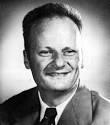
Hans Bethe |
birth Hans Bethe Hans Bethe (died 2005), Nobel Prize Physicist. |
|
05 Jul 1906

Paul Drude |
death Paul Drude Paul Drude (born 1863), German physicist (suicide). |
|
15 Aug 1906
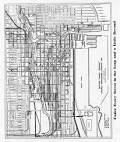
Chicago freight tunnels |
Chicago freight tunnels In 1906, a freight delivery tunnel system, the first in the U.S., began operation underneath Chicago, Illinois, but the whole underground system was not finished until 1 Sep 1907. The finished system was put into operation on 2 Jan 1908. The original franchise was issued to the Illinois Telephone and Telegraph Company, 20 Feb 1899 for carrying telephone and telegraph cables. After about twenty miles of tunnel had been accomplished, funds were exhausted. The concern was sold to a new company, the Illinois Tunnel Company, which obtained powers to handle merchandise and package freight between stores, warehouses and delivery points. |
|
19 Aug 1906
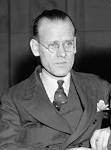
Philo T. Farnsworth |
birth Philo T. Farnsworth Philo T. Farnsworth (died 1971), television pioneer. |
|
01 Sep 1906

yellow fever |
yellow fever (medicine) Last death from yellow fever in the Panama Canal Zone following a mosquito eradication program led by William C. Gorgas. |
|
01 Sep 1906
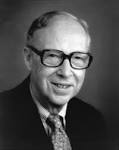
Karl August Folkers |
birth Karl August Folkers Karl August Folkers (died 1997), biochemist. |
|
04 Sep 1906
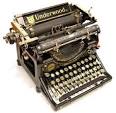
Typewriter |
Typewriter In 1906, U.S. patent No. 830,115 was issued to Robert Eugene Turner of Norfolk, Virginia, for his invention of a "Type Writing Machine,"(typewriter) with a carriage powered by a motor to "return automatically when the end of the writing-line is reached, also to return same by pressing a key-lever on the keyboard to return the carriage at any point of its stroke." Also, line spacing was provided by manual or automatic means. A low-powered motor was adapted to feed the carriage in the printing direction, a high-powered motor for returning the carriage in the reverse direction, and the necessary mechanism to control their action. A buffering mechanism was included to reduce the impact of the returning carriage at the end of its reverse stroke. |
|
04 Sep 1906

Max Delbrück |
birth Max Delbrück Max Delbrück (died 1981), biologist. |
|
05 Sep 1906

Ludwig Boltzmann |
death Ludwig Boltzmann Ludwig Boltzmann (born 1844), Austrian physicist. |
|
30 Sep 1906
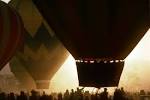
First international ballon race |
First international ballon race In 1906, the world's first international balloon race began. It was won by a coal-gas balloon, the United States. Pilot Lt. Frank P. Lahm of the U.S. Signal Corps and his co-pilot Maj. Henry B. Hersey, of the Weather Bureau, flew 402 miles (647-km) from Paris, France, to Scarborough, England, in 22-hr 15-min, to win the Gordon-Bennett Cup. The race sponsor, James Gordon-Bennett (1841-1918), publisher of the New York Herald, was known for financing Henry Stanley's expedition into Africa to find David Livingstone. The 1906 balloon race launched at the Jardin des Tuleries, with 250,000 spectators. Of 17 entrants, only seven reached England safely. The American win promoted ballooning back home, and nominated the U.S. as host for the next race, in 1907, held at St. Louis, Missouri. |
|
01 Oct 1906

sex reassignment surgery |
sex reassignment surgery (medicine) December – Martha Baer undergoes sex reassignment surgery to become Karl M. Baer in Germany. |
|
02 Oct 1906

Willy Ley |
birth Willy Ley Willy Ley (died 1969), scientific populariser. |
|
18 Oct 1906
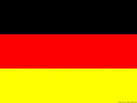
German |
German (technology) German inventor Arthur Korn demonstrates the transmission of a photograph electronically over a distance of 1800 km using his Bildetelegraph or phototelautograph system. |
|
03 Nov 1906
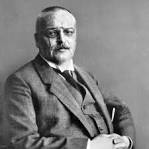
Alois Alzheimer |
Alois Alzheimer (medicine) A speech given by Alois Alzheimer for the first time presents the pathology and clinical symptoms of pre-senile dementia together; the condition will rapidly become known as Alzheimer's disease. |
|
03 Nov 1906

Carl Benjamin Boyer |
birth Carl Benjamin Boyer Carl Benjamin Boyer (died 1976), historian of mathematics. |
|
05 Nov 1906
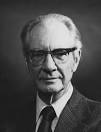
Fred Lawrence Whipple |
birth Fred Lawrence Whipple Fred Lawrence Whipple (died 2004), American astronomer who coined the term "dirty snowball" to explain the nature of comets. |
|
12 Nov 1906

Deutsches Museum |
Deutsches Museum First displays of the Deutsches Museum open to the public in Munich. |
|
18 Nov 1906

George Wald |
birth George Wald George Wald (died 1997), scientist. |
|
20 Nov 1906
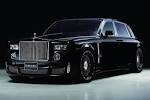
Rolls-Royce |
Rolls-Royce In 1906, Charles Stewart Rolls and Frederick Henry Royce formed Rolls-Royce. |
|
20 Nov 1906

Crystal Detector |
Crystal Detector In 1906, a U.S. patent was issued for the crystal detector, which was one of the first devices widely used for receiving radio broadcasts (until superseded by the triode vacuum tube). It was invented by Greenleaf Whittier Pickard, a U.S. electrical engineer. His patent described it as "a means for receiving intelligence communicated by electric waves." |
|
09 Dec 1906
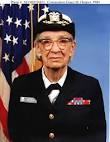
Grace Hopper |
birth Grace Hopper Grace Hopper (died 1992), American computer scientist. |
|
24 Dec 1906
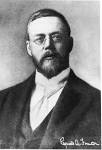
Reginald Fessenden |
Reginald Fessenden (technology) Reginald Fessenden makes the first radio broadcast, including a musical recording, a violin solo, and readings, from Brant Rock, Massachusetts. |
|
25 Dec 1906

Ernst Ruska |
birth Ernst Ruska Ernst Ruska (died 1988), German Nobel Prize Physicist. |